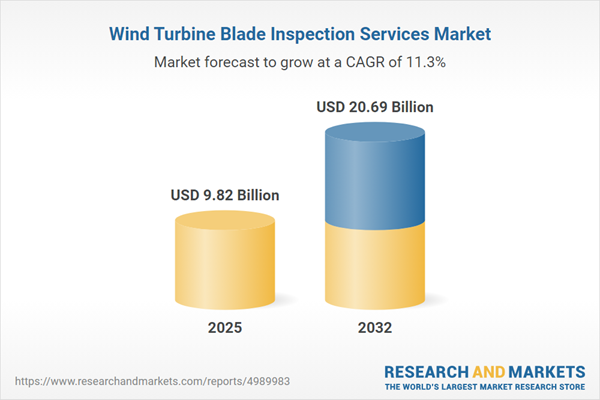Speak directly to the analyst to clarify any post sales queries you may have.
The wind turbine blade inspection services market is experiencing transformation as operators prioritize digitalization, automation, and smarter maintenance strategies to extend the lifespan and reliability of renewable energy assets. Proactive asset management, powered by technology-enabled solutions, is becoming a cornerstone for organizations seeking long-term asset performance in the wind sector.
Market Snapshot: Wind Turbine Blade Inspection Services
The wind turbine blade inspection services market is expanding in response to increasing system resilience demands, heightened regulatory requirements, and the shift towards digital transparency. Strategic investments in drone-based and data-driven inspection methods are driving material reductions in manual maintenance, improving accuracy, and providing operators with deeper insights into the condition of critical wind assets. Service providers are upgrading digital infrastructure and evolving service models to address changing regional policies, regulatory compliance, and to maximize turbine uptime. This makes blade inspection critical for asset management across global wind energy portfolios and a key aspect for growth-focused organizations.
Scope & Segmentation
This report offers clear, actionable intelligence for senior decision-makers seeking to advance competitiveness and upgrade their approach in the wind turbine blade inspection services sector. Market segmentation and dynamic trends are as follows:
- Inspection Techniques: Advanced approaches such as acoustic emission, thermography, ultrasonic testing, laser shearography, and visual inspections are standard across a broad array of projects.
- Technology Platforms: Both drone and rope access solutions deliver consistent detection quality for onshore and offshore projects, responding to varying inspection requirements and site conditions.
- Service Modes: Inspection providers offer drones, rope-based access, and remote monitoring, allowing customized strategies for different wind farm scales, maintenance cycles, and regional environments.
- Turbine Rated Capacity: Service offerings are segmented to address turbines above 3 MW, those below 2 MW, and intermediate capacities, enabling precise maintenance planning and resource allocation.
- Blade Materials: Inspection solutions are tailored to blade construction, covering carbon fiber, glass fiber, and hybrid composites, ensuring materials-specific protocols and lifecycle maintenance.
- End Users: Solutions are designed for both commercial wind farm operators and residential asset owners, supporting distinct business priorities and operational needs.
- Geographical Coverage: The report assesses regions including the Americas, Europe, Middle East & Africa, and Asia-Pacific, highlighting local regulatory climates, infrastructure maturity, and market adoption levels.
- Leading Companies: Market innovation is shaped by General Electric Company, Siemens Gamesa Renewable Energy S.A., Vestas Wind Systems A/S, MISTRAS Group, TÜV SÜD AG, SGS SA, DNV AS, Bureau Veritas SA, Intertek Group plc, and Underwriters Laboratories LLC.
Key Takeaways for Decision-Makers
- Automation and drone-powered inspections are enabling operators to shift from responsive to proactive asset maintenance and risk reduction.
- Digital platforms streamline regulatory compliance, supporting rapid response to shifting policies and transparency expectations across key geographies.
- The adoption of machine learning, digital twin modeling, and enhanced sensor arrays supports predictive analytics and resource efficiency.
- Upgraded inspection sensors and new composite blade materials are directly contributing to operational optimization and sustainability aspirations.
- Distinguishing inspection protocols for regional compliance reinforces supply chain flexibility and secure asset operations in diverse markets.
- Emerging alliances among technology suppliers, equipment manufacturers, and service providers are resulting in more responsive inspection solutions for an evolving industry landscape.
Tariff Impact & Strategic Response
Forthcoming changes to U.S. tariffs in 2025 are motivating inspection service providers to re-engineer supply chains by using domestically sourced materials and investing in proprietary sensor and additive manufacturing. This transition supports resilience against trade volatility and ensures ongoing regulatory compliance through in-market technical innovation.
Methodology & Data Sources
The findings within this report are the result of comprehensive interviews with sector experts, specialist literature reviews, and regulatory policy analysis. Scenario modeling and sensitivity analysis underpin practical executive guidance in line with current and projected market risks.
Why This Report Matters
- Empowers senior teams to modernize asset management strategies by leveraging digital transformation in wind turbine blade inspection services, reinforcing compliance and operational control.
- Provides the actionable insight required for informed decisions around market positioning, investment strategies, and successful expansion into priority regions.
- Supports scaling of inspection capabilities to keep pace with automation and the ongoing digitalization of the sector, enhancing both competitiveness and efficiency.
Conclusion
Adoption of advanced digital inspection methods, combined with decisive executive actions, enables organizations to meet evolving compliance needs, safeguard long-term asset value, and propel renewable energy objectives.
Additional Product Information:
- Purchase of this report includes 1 year online access with quarterly updates.
- This report can be updated on request. Please contact our Customer Experience team using the Ask a Question widget on our website.
Table of Contents
3. Executive Summary
4. Market Overview
7. Cumulative Impact of Artificial Intelligence 2025
Companies Mentioned
The companies profiled in this Wind Turbine Blade Inspection Services market report include:- General Electric Company
- Siemens Gamesa Renewable Energy S.A.
- Vestas Wind Systems A/S
- MISTRAS Group, Inc.
- TÜV SÜD AG
- SGS SA
- DNV AS
- Bureau Veritas SA
- Intertek Group plc
- Underwriters Laboratories LLC
Table Information
| Report Attribute | Details |
|---|---|
| No. of Pages | 189 |
| Published | October 2025 |
| Forecast Period | 2025 - 2032 |
| Estimated Market Value ( USD | $ 9.82 Billion |
| Forecasted Market Value ( USD | $ 20.69 Billion |
| Compound Annual Growth Rate | 11.2% |
| Regions Covered | Global |
| No. of Companies Mentioned | 11 |









